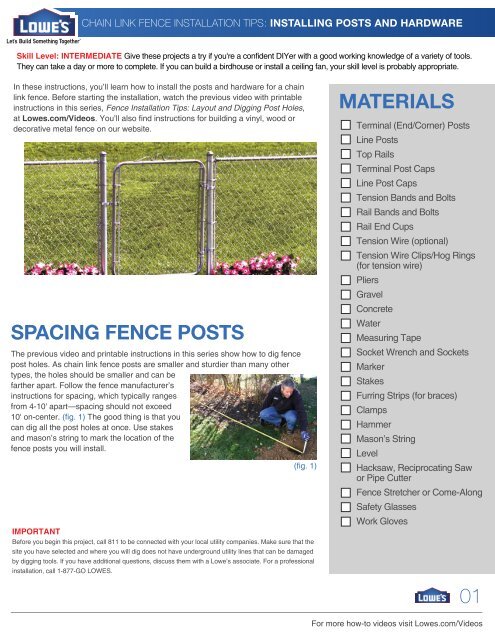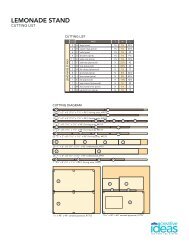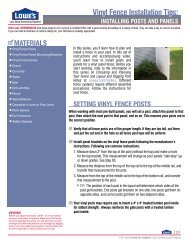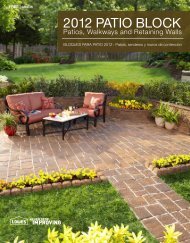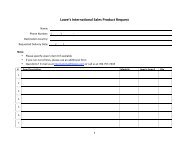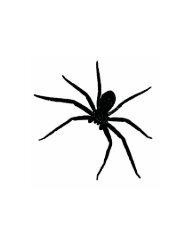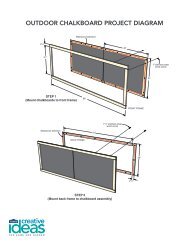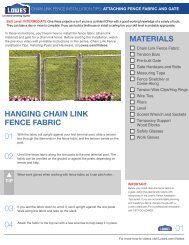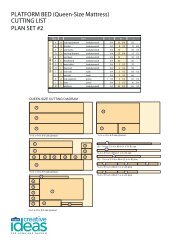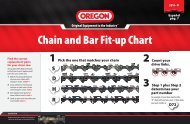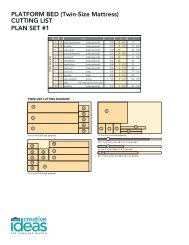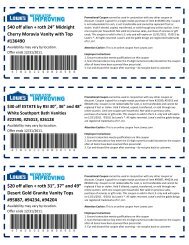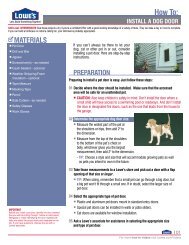Chain Link Fence Installation Tips-Installing Posts and ... - Lowe's
Chain Link Fence Installation Tips-Installing Posts and ... - Lowe's
Chain Link Fence Installation Tips-Installing Posts and ... - Lowe's
- No tags were found...
You also want an ePaper? Increase the reach of your titles
YUMPU automatically turns print PDFs into web optimized ePapers that Google loves.
CHAIN LINK FENCE INSTALLATION TIPS: INSTALLING POSTS AND HARDWARESkill Level: INTERMEDIATE Give these projects a try if you're a confident DIYer with a good working knowledge of a variety of tools.They can take a day or more to complete. If you can build a birdhouse or install a ceiling fan, your skill level is probably appropriate.In these instructions, you’ll learn how to install the posts <strong>and</strong> hardware for a chainlink fence. Before starting the installation, watch the previous video with printableinstructions in this series, <strong>Fence</strong> <strong>Installation</strong> <strong>Tips</strong>: Layout <strong>and</strong> Digging Post Holes,at Lowes.com/Videos. You’ll also find instructions for building a vinyl, wood ordecorative metal fence on our website.SPACING FENCE POSTSThe previous video <strong>and</strong> printable instructions in this series show how to dig fencepost holes. As chain link fence posts are smaller <strong>and</strong> sturdier than many othertypes, the holes should be smaller <strong>and</strong> can befarther apart. Follow the fence manufacturer’sinstructions for spacing, which typically rangesfrom 4-10' apart—spacing should not exceed10' on-center. (fig. 1) The good thing is that youcan dig all the post holes at once. Use stakes<strong>and</strong> mason’s string to mark the location of thefence posts you will install.(fig. 1)IMPORTANTBefore you begin this project, call 811 to be connected with your local utility companies. Make sure that thesite you have selected <strong>and</strong> where you will dig does not have underground utility lines that can be damagedby digging tools. If you have additional questions, discuss them with a Lowe’s associate. For a professionalinstallation, call 1-877-GO LOWES.MATERIALSTerminal (End/Corner) <strong>Posts</strong>Line <strong>Posts</strong>Top RailsTerminal Post CapsLine Post CapsTension B<strong>and</strong>s <strong>and</strong> BoltsRail B<strong>and</strong>s <strong>and</strong> BoltsRail End CupsTension Wire (optional)Tension Wire Clips/Hog Rings(for tension wire)PliersGravelConcreteWaterMeasuring TapeSocket Wrench <strong>and</strong> SocketsMarkerStakesFurring Strips (for braces)ClampsHammerMason’s StringLevelHacksaw, Reciprocating Sawor Pipe Cutter<strong>Fence</strong> Stretcher or Come-AlongSafety GlassesWork Gloves01For more how-to videos visit Lowes.com/Videos
CHAIN LINK FENCE INSTALLATION TIPS: INSTALLING POSTS AND HARDWARESETTING TERMINAL POSTSThe following steps explain how to set chain link fence corner, end,<strong>and</strong> gate posts in concrete. These posts are also referred to asterminal posts. (fig. 2)01Calculate the height of the terminal posts to be installed:1. Measure the height of the chain link fabric.Add 2" to allow for attachment of the rail b<strong>and</strong> <strong>and</strong> cap.2. This measurement is where the ground will line up withthe post. Mark that measurement on the post.3. Add the depth of the post that will be in the ground, followinglocal building code or manufacturer’s instructions.<strong>Chain</strong> link fabric height+ 2"+ Depth of post in groundTotal post heightCut the terminal post if necessary.!0203TIPAdd gravel to the bottom of the post hole for drainage. Make sure the mark you made on the post earlier isat ground level.Check with local building regulations to determine how much gravel is required in the hole <strong>and</strong> how deep the postmust be set below the frostline.(fig. 2)04Set a terminal post in place against the layout line. Use a level toadjust it for plumb. Temporarily hold the post with clamps <strong>and</strong>braces. (fig. 3)05Add concrete following the manufacturer’s instructions, working itto about 2" below the surface to allow for fill dirt later.06Verify that the post is still plumb with a level.(fig. 3)02For more how-to videos visit Lowes.com/Videos
CHAIN LINK FENCE INSTALLATION TIPS: INSTALLING POSTS AND HARDWARESETTING TERMINAL POSTSContinue installing terminal posts at ends, corners <strong>and</strong> gates.07(cont.)!Calculate the height of the line post(s) to be installed:TIPWhen setting posts for the gate(s), allow sufficient space for hardware installation. Check the manufacturer’srecommendation, as some account for the hardware in the gate’s listed size. For example, a 42" gate is actuallynarrower so it will fit in a 42" opening with the hinges <strong>and</strong> latch.TIPCut a scrap board to the full gate width to use as a spacer between gate posts to make precise gate postplacement easier.SETTING LINE POSTSThe next steps explain how to set chain link fence line posts betweenterminal posts. (fig. 4)011. Measure the height of the chain link fabric.2. Subtract 2" from the height to allow for the top rail.3. Add the depth of the post that will be in the ground,following local building code or manufacturer’s instructions.<strong>Chain</strong> link fabric height– 2"+ Depth of post in groundTotal post height(fig. 4)020304Cut the line post if necessary.Add gravel to the bottom of the post hole for drainage. Make sure the mark you made earlier is at ground level.Set the line post in place against the layout line, adjust it for plumb, <strong>and</strong> temporarilysupport it in place with braces.03For more how-to videos visit Lowes.com/Videos
CHAIN LINK FENCE INSTALLATION TIPS: INSTALLING POSTS AND HARDWARESETTING LINE POSTS (cont.)05Add concrete following the manufacturer’s instructions, working it to 2" below the ground surface.060708Verify that the post is still plumb with a level.Continue installing line posts, evenly spaced between terminal posts.Allow all concrete to thoroughly dry before continuing installation.INSTALLINGPOST HARDWARE01Install the terminal post hardware. (fig. 5)1. Add the tension b<strong>and</strong>s <strong>and</strong> bolts.The number of tension b<strong>and</strong>s you’ll need is the heightof the fence (in feet) minus one. For example, for a4' fence, install 3 tension b<strong>and</strong>s.Make sure the flat surface of the b<strong>and</strong> is on the fabricside of the fence. (fig. 6)For corner posts, add an extra set of b<strong>and</strong>s for the adjacent run of fence.2. Install the top rail b<strong>and</strong>s, cups <strong>and</strong> bolts. (fig. 7)If installing on a corner post, alternate the end cups—bottom one up,top one down.(fig. 5)(fig. 6)3. Add the post caps to the terminal posts.(fig. 7)04For more how-to videos visit Lowes.com/Videos
CHAIN LINK FENCE INSTALLATION TIPS: INSTALLING POSTS AND HARDWAREINSTALLING POST HARDWAREInstall the line post hardware. (fig. 8)021. Install line post tops with the offset ring on the fence side.2. Slide the top rail through the line post top <strong>and</strong> into the rail end cup, thentighten the bolt.3. Continue installing top rails along the line. The narrower end slides into thewider end.4. Cut the final top rail in the line to fit snugly inside the rail end cup, <strong>and</strong>secure with a bolt. (fig. 9)(cont.)(fig. 8)03Install optional tension wire along the bottom to help keep pets from squeezingunder the fence.1. Add rail b<strong>and</strong>s <strong>and</strong> bolts to the bottom of the terminal posts.2. Secure the tension wire to the bottom rail b<strong>and</strong> with pliers, making a loop<strong>and</strong> twisting a few times. (fig. 10)3. Run the wire along the outside of the posts <strong>and</strong> connect it to the rail b<strong>and</strong> onthe other terminal post.(fig. 9)TIPIf you can’t get the tension wire taught, use a fence stretcher or come-along(used to stretch fence fabric) to stretch the tension wire.04Install the tension wire clips or hog ring clips about every 2' on the tension wire.The clips will be attached to the chain link fence fabric in the next video <strong>and</strong>printable instructions in this series.(fig. 10)Now that your posts <strong>and</strong> hardware have been installed, your new chain link fence is ready for the fence fabric <strong>and</strong>gates. See <strong>Chain</strong> <strong>Link</strong> <strong>Fence</strong> <strong>Installation</strong> <strong>Tips</strong>: Attaching <strong>Fence</strong> Fabric <strong>and</strong> Gate, at Lowes.com/Videos.These How-To's are provided for informational purposes only. The information contained in <strong>Lowe's</strong> "How-To" videos <strong>and</strong> printable instructions is intended toprovide general guidance to simplify jobs around the house. Because tools, products, materials, techniques, building codes <strong>and</strong> local regulations are continuallychanging, <strong>Lowe's</strong> assumes no responsibility for the accuracy of the information contained herein <strong>and</strong> disclaims any liability for omissions, errors or the outcomeof any project. It is the responsibility of the viewer <strong>and</strong> reader to ensure compliance with all applicable laws, rules, codes <strong>and</strong> regulations for a project. Theviewer or reader must always take proper safety precautions <strong>and</strong> exercise caution when taking on any project. If there is any question or doubt in regards to anyelement of a project, please consult with a licensed professional.05For more how-to videos visit Lowes.com/Videos


